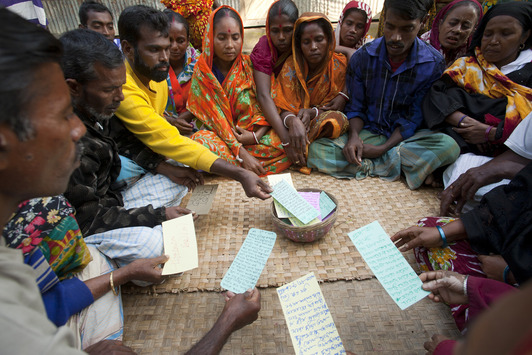Participatory approaches
A participatory approach is an approach in which the end users of a sanitation or water system are involved in the planning of the system from the start. This contrasts to the more traditional top-down methods of planning, in which the needs of users were often 'filled in' by officials, who might have a different perception of actual needs of the users. A good participatory approach improves motivation, increases learning and feelings of ownership and enables community empowerment. By raising awareness about the water or sanitation issues, it enables the users to make an 'informed choice' about what will become their system.
Participation of the users is now seen as essential to attain sustainable development. First of all, involving and informing the users helps in ensuring that the identified problems and chosen solutions really reflect the needs and preferences felt by the users. This increases the chance that implemented solutions are really used. Systems which are perceived to be inconvenient, difficult to operate, or in other ways do not correspond to the needs and preferences of the users have a high chance of not being used, or adapted in ways that cause pollution or health risks.
A participatory approach brings together representatives of all the local stakeholders. This is often a diverse group of users, health workers, NGO's, etc, who might not usually work together, might come from different backgrounds, and have different values and interests. A constructive and democratic group learning and action planning process is initiated, often using visual methods of communication.
Participatory approaches have in many cases shown good results in water supply and sanitation programmes. As most of the approaches that have been developed up to now have focussed on more densely populated urban or peri-urban areas in mind, care must be taken in each particular case to choose the appropriate technology options. For example, in a rural setting it is important to consider the reuse of sanitation products.
Many different Participatory approaches have been developed in the past. Below, we highlight the NETSAFF and PHAST approaches, and provide a list of additional approaches.
NETSAFF
NETSSAF stands for "Network for the development of Sustainable Approaches for large scale implementation of Sanitation in Africa". NATSSAF was a project that started in June 2006 and which was sponsored by the European Commission. It's goal was to identify sustainable sanitation systems in peri-urban and rural areas.
During NETSSAF, a participatory planning approach was developed, focusing on seven steps for the planning and implementation of sanitiation programmes in a community, with emphasis on peri-urban and rural ares. The approach targets planners of sanitation programmes in West Africa. The approach was developed by 19 organizations from West Africa and Europe.
A second result of the NETSSAF project was the yellow pages database which provides information of:
- providers of complete sanitation systems or individual components for the collection, transportation, treatment and reuse of waste.
- providers of design, planning and general consulting on both technical and non-technical aspects of sanitation.
PHAST
Participatory Hygiene and Sanitation Transformation (PHAST) is designed to promote hygiene behaviour and sanitation improvements at community level using a specifically developed participatory technique. The approach has been applied with positive results although research is needed to assess its cost effectiveness. Typically it is applied by NGOs to improve household and personal hygiene behaviour together with toilet coverage. Links to information can be found below.
PHAST was developed and applied in East and southern Africa, and adapted to other countries such as Somalia and the Dominican Republic. It consists of a participatory approach in which people learn about their situation, make plans to improve this and then change their behaviour. Special techniques, such as mapping and ranking, are used for this process of self-discovery and analysis. The approach can be used where initial latrine coverage is low.
Other participatory approaches
An overview of different Participatory Approaches can be found in this review of participatory sanitation planning tools, produced by the NETSAFF project.
Some other participatory approaches include:
- Refer also to Participatory_Facilitation
- Open planning1
- Sanitation 212
- Household-Centered Environmental Sanitation (HCES) 3
- Practical Guide to Triggering Community-Led Total Sanitation (CLTS)
Links
PHAST
- Somali PHAST step-by-step guide (2007), IRC.
- WHO - Participatory hygiene and sanitation transformation: A new approach to working with communities (2001 reprint)
- WHO - PHAST step-by-step guide: A participatory approach for the control of diarrhoeal diseases (1998). (French version also available)
- Simpson-Herbert, M., Sawyer, R. & Clarke, L. (1997). The PHAST initiative.
- WHO - Experiences in pilot countries (Botswana, Kenya, Uganda, Zimbabwe)
- Environment and health: WHO proposes a strategy for the African region
NETSSAF
- NETSSAF Participatory Planning Approach
- NETSAFF Yellow Pages - a directory of sanitation system providers

